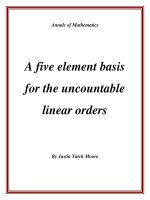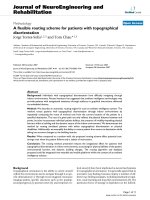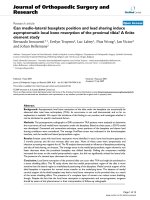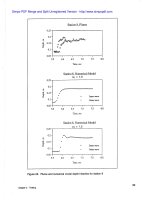CHL - A Finite Element Scheme for Shock Capturing_6 potx
Bạn đang xem bản rút gọn của tài liệu. Xem và tải ngay bản đầy đủ của tài liệu tại đây (358.41 KB, 8 trang )
Figure
35.
Relative amplitude versus
C
and resolution for
at
=
1.0
and
a
=
0
Elements per Wavelength
Figure
36.
Relative speed versus
C
and resolution for
at
=
1.0
and
a
=
0
Chapter
3
Testing
Simpo PDF Merge and Split Unregistered Version -
Relative Amplitude
o.
Elements per Wavelength
Figure
37.
Relative amplitude versus
C
and resolution for
at
=
1.0 and
a
=
0.25
Elements per Wavelength
Figure
38.
Relative speed versus
C
and resolution for
at
=
1
.O and
a
=
0.25
Chapter
3
Testing
Simpo PDF Merge and Split Unregistered Version -
Relative Amplitude
o.
Elements per Wavelen
Figure
39.
Relative amplitude versus
C
and resolution for
at
=
1.5
and
a
=
0
Relative Speed
0.
Elements per Wavelength
Figure
40.
Relative speed versus
C
and resolution for
at
=
1.5
and
a
=
0
Chapter
3
Testing
Simpo PDF Merge and Split Unregistered Version -
Relative Amplitude
Elements per Wavelength
Figure 41. Relative amplitude versus
C
and resolution for
at
=
1.5 and
a
=
0.25
Figure 42. Relative speed versus
C
and resolution for
at
=
1.5
and
a
=
0.25
Chapter
3
Testing
Simpo PDF Merge and Split Unregistered Version -
4
Conclusions
In this report an algorithm is developed to address the numerical difficulties
in modeling surges and jumps in a computational hydraulics model. The
model itself is a finite element computer code representing the 2-D shallow
water equations.
The technique developed to address the case of advection-dominated flow is
a dissipative technique that serves well for the capturing of shocks. The
dissipative mechanism is large for short wavelengths, thus enforcing energy
loss through the hydraulic jump, unlike a nondissipative technique used on
C"
representation of depth, which will implicitly enforce energy conservation,
dictated by the shallow-water equations, through a
2A.x
oscillation.
The test cases demonstrate that the resulting model converges to the correct
heights and shock speeds with increasing resolution. Furthermore, general 2-D
cases of lateral transition in supercritical flow showed the model to compare
quite well in reproducing the oblique shock pattern.
The trigger mechanism, based upon energy variation, appears to detect the
jump quite well. The Petrov-Galerkin technique shown is an intuitive method
relying upon characteristic speeds and directions and produces a 2-D model
which is adequate to address hydraulic problems involving jumps and oblique
shocks.
The resulting improved numerical model will have application in
supercriti-
cal as well as subcritical channels, and transitions between regimes. The
model can determine the water surface heights along channels and around
bridges, confluences, and bends for a variety of numerically challenging events
such as hydraulic jumps, hydropower surges, and dam breaks. Furthermore,
the basic concepts developed are applicable to models of aerodynamic flow
fields, providing enhanced stability
in
calculation of shocks on engine or heli-
copter rotors, for example, as well as on high-speed aircraft.
Chapter 4
Discussion
Simpo PDF Merge and Split Unregistered Version -
References
Anderson, D. A., Tannehill, J. C., and Pletcher, R. H. (1984).
Computational
fluid
mecllanics and heat transfer.
Hemisphere Publishing, Washington,
DC.
Bell, S. W., Elliot,
R.
C., and Chaudhry,
M.
H. (1992). "Experimental results
of two-dimensional dam-break flows,"
Journal of Hydraulic Research
30(2), 225-252.
Berger, R.
C.
(1992). "Free-surface flow over curved surfaces," Ph.D. diss.,
University of Texas at Austin.
Berger, R. C., and
Winant, E. H.
(1991). "One dimensional finite element
model for spillway flow."
Hydraulic Engineering,
Proceedings, 1991
National Conference, ASCE, Nashville, Tennessee, July 29-August 2, 1991.
Richard
M.
Shane, ed., New York, 388-393.
Courant, R., and Friedrichs, K. 0. (1948).
Supersonic flow and shock waves,
Interscience Publishers, New York, 121-126.
Courant, R., Isaacson, E., and Rees,
M.
(1952). "On the solution of nonlinear
hyperbolic differential equations,"
Communication on Pure and Applied
Mathematics
5, 243-255.
Dendy,
J.
E.
(1974). "Two methods of Galerkin-type achieving optimum
L~
rates of convergence for first-order hyperbolics,"
SlAM
Journal of Numeri-
cal Analysis
11, 637-653.
Froehlich,
D.
C.
(1985).
Discussion of "A dissipative Galerkin scheme for
open-channel flow," by N. D. Katopodes,
Jountal of Hydraulic
Engineering,
ASCE, 111(4), 1200- 1204.
Gabutti,
B.
(1983). "On two upwind finite different schemes for hyperbolic
equations in non-conservative form,"
Coinputers and Fluids
11(3), 207-230.
Hicks, F. E., and Steffler,
P.
M.
(1992). "Characteristic dissipative Galerkin
scheme for open-channel flow,"
Jortrnal of Hydraulic Engineering,
ASCE,
118(2), 337-352.
References
Simpo PDF Merge and Split Unregistered Version -
Hughes, T. J. R., and Brooks, A. N.
(1982). "A theoretical framework for
Petrov-Galerkin methods with discontinuous weighting functions: Applica-
tions to the streamline-upwind procedures."
Finite Elements in Fluids.
R. H. Gallagher, et al., ed.,
J.
Wiley and Sons, London, 4, 47-65.
Ippen, A. T., and Dawson, J. H.
(1951). "Design of channel contractions,"
High-velocity flow in open channels:
A
symposium.
Transactions ASCE,
116, 326-346.
Katopodes, N.
D.
(1986). "Explicit computation of discontinuous channel
flow,"
Journal of Hydraulic Engineering,
ASCE, 112(6), 456-475.
Keulegan, G. H. (1950). "Wave motion."
Engineering Hydraulics,
Proceed-
ings, Fourth Hydraulics Conference, Iowa Institute of Hydraulic Research,
June 12-15, 1949. Hunter Rouse, ed., John Wiley and Sons, New York,
748-754.
Leendertse, J. J. (1967). "Aspects of a computational model for long-period
water-wave propagation," Memorandum RM 5294-PR, Rand Corporation,
Santa Monica, CA.
Moretti, G. (1979). "The A-scheme,"
Computers in Fluids
7(3), 191-205.
Platzman, G. W. (1978). "Normal modes of the world ocean; Part
1,
Design
of a finite element barotropic model,"
Journal of Physical Oceanography
8, 323-343.
Steger, J.
L.,
and Warming, R. F. (1981). "Flux vector splitting of the
inviscid gas dynamics equations with applications to finite difference
methods,"
Journal of Computational Physics
40, 263-293.
Stoker,
J.
J. (1957).
Water waves: The mathematical theory with applica-
tions.
Interscience Publishers, New York, 314-326.
Von Neumann, J., and Richtmyer, R.
D.
(1950). "A method for the numerical
calculation of hydrodynamic shocks," Journal of Applied Physics 21,
232-
237.
Walters, R. A., and Carey,
G.
F. (1983). "Analysis of spurious oscillation
modes for the shallow water and Navier-Stokes equations,"
Journal of
Computers and
Fluih,
11(1), 51-68.
References
Simpo PDF Merge and Split Unregistered Version -
REPORT DOCUMENTATION PAGE
Form Approved
OMB
NO.
0704-0188
Finite Element Scheme for Shock Capturing
I
. Army
Engineer Waterways Experiment Station
aulics Laboratory
Halls Ferry Road, Vicksburg, MS 39180-6199
Technical Report
HL-93-12
sistant Secretary of the Army (R&D)
shington,
DC
20315
vailable from National Technical Information Service, 5285 Port Royal Road, Springfield, VA 22161.
I"
12b.
DISTRIBUTION
CODE
ing up O(1) errors, but restricting the error to the neighborhood of the jump or shock. This technique is called
ction matrix. Furthermore, in order to restrict the shock capturing to the vicinity of the jump, a method of
detection is implemented which depends on the variation of mechanical energy within an element.
The veracity of the
model is tested by comparison of the predicted jump speed and magnitude with
nalytic
and flume results. A comparison is also made to a flume case of steady-state supercritical lateral
1SN
7540-01 -280-5500
Standard
Form
298
(Rev.
2-89)
Prescr~bed
by
ANSI
Std
239-18
298-102
Simpo PDF Merge and Split Unregistered Version -









